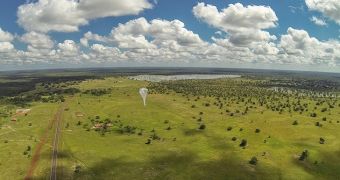Google Loon has already been around for a year and the Internet giant is celebrating the event with an LTE experiment and launch near the equator.
“As winter begins in the Southern hemisphere, many Brazilians are sending paper balloons skyward in celebration of Festa Junina, a festival celebrating the winter solstice. Project Loon was honored to join in the festivities this year with our own balloon launch in the rural outskirts of Campo Maior, where we connected Linoca Gayoso, a local school, to the Internet for the first time,” starts off a post published by the Project Loon Google+ account.
The company explains that the vast majority of this community doesn’t have Internet access or even cell service, but the locals are aware of a few spots in town where a weak signal may be found.
“But with the Project Loon team in town and one of our balloons overhead, the students in Tiao’s geography class were able to get to the Internet from their classroom for the first time as they learned about world cultures,” the team writes, basically pointing out the main reason why Google is trying to make Project Loon work.
The members of the team admit that this was a learning experience for them too, as they learned how to overcome more dramatic temperature profiles and the high humidity by launching its balloons near the equator.
LTE technology was tested for the first time and this is a huge step because it enables the company to provide an Internet signal directly to mobile phones, which opens up more options for delivering Internet access to more places.
Project Loon was launched so that Google could help the billions of people that aren’t connected to the Internet come online. Since most of these don’t have an Internet connection because they live in areas where the infrastructure doesn’t exist, the company thought it was best to deliver a signal from the sky.
At over 60,000 feet, Google’s balloons can be directed to reach any area in the world by traveling the winds; an ambitious project that many laughed at, but which is taking shape in spite of everyone’s disbelief.
Over the next few months, Google hopes to run even more flights that last more than 100 days until launching up to 400 balloons. The company hopes that by next year, there will be permanent balloons up in the air and not just tests.

 14 DAY TRIAL //
14 DAY TRIAL //